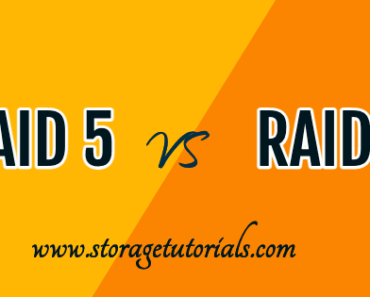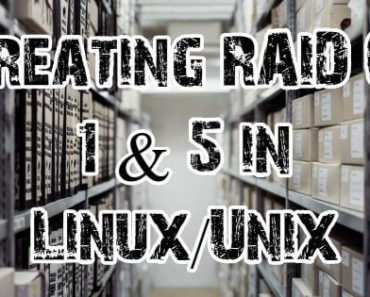If you want to work as a Storage administrator or a SAN, NAS expert, then you should have good knowledge of some basic terms in storage and backup. Today we are going to talk about basic RAID levels, which you must understand.
As you must be knowing that RAID is the most widely used data protection technology that is used today and multiple disks work as part of a set to provide protection against HDD failures. Striping, Mirroring & Parity are the three basics of RAID levels, which we are going to discuss.
Striping, Mirroring & Parity
1. Striping:
For me, Striping is the most confusing RAID level as a beginner and needs a good understanding and explanation. We all know that RAID is a collection of multiple disk’s and in these disks, a predefined number of contiguously addressable disk blocks are defined which are called as strips and collection of such strips in aligned in multiple disks is called stripe.
Suppose you have hard disk, which is a collection of multiple addressable blocks and these blocks are stacked together and called strip and you have multiple such hard disks, which are place parallel or serially. Then such a combination of disks is called stripe.
Note: Without mirroring and parity, Striped RAID cannot protect data but striping may significantly improve I/O performance.
2. Mirroring:
Mirroring is very simple to understand and one of the most reliable ways of data protection. In this technique, you just make a mirror copy of disk which you want to protect and in this way you have two copies of data. In time of failure, the controller uses a second disk to serve the data, thus making data availability continuous.
When the failed disk is replaced with a new disk, the controller copies the data from the surviving disk of the mirrored pair. Data is simultaneously recorded on both the disk. Though this type of RAID gives you the highest availability of data, but it is costly as it requires double the amount of disk space and thus increases the cost.
Recommended Article: Difference between RAID 10 & RAID 01
3. Parity:
As explained above, mirroring involves high cost, so to protect the data new technique is used with striping called parity. This is a reliable and low-cost solution for data protection. In this method, an additional HDD or disk is added to the stripe width to hold the parity bit.
Parity is a redundancy check that ensures full protection of data without maintaining a full set of duplicate data.
The parity bits are used to re-create the data at the time of failure. Parity information can be stored on separate, dedicated HDDs or distributed across all the drives in a RAID set. In the above image, parity is stored on a separate disk.
Recommended Article: RAID 5 vs RAID 6
The first three disks, labeled D, contain the data. The fourth disk, labeled P, stores the parity information, which in this case is the sum of the elements in each row. Now, if one of the Disks (D) fails, the missing value can be calculated by subtracting the sum of the rest of the elements from the parity value.
Hope you have understood the basic of these RAID levels. If you have any issues or concerns, please let us know through your emails and comment.





Good explanation. Thanks.
WOW, a very crystal clear explanation. Thanks
Keep up the good work.
Thanks Hussain for your kind words. Keep visiting our site for more.
Great simple articulation. Thanks for sharing.
Thanks for liking our article. Keep visiting.
ok,means 2 disk failure will not retrive dat
I have a question about the post,if D2 and p are fails both then how can i retrieve the data.
Only one disk failure is allowed Sudip.
ok,means 2 disk failure will not retrive data
Hi,
I have one doubt, for example, if disk d1 is failed in parity, then how to recover the data from parity disk.
Please explain the parity calculation in detail.
Thanks
Hi Raghuramn,
XOR is used for calculating data. If the drive fails, system can use earlier correct data to build failed disk data.
This documents is really helpful to understand basic RAID. However, do you have any documents related to SAN. I would like to know each and every things related to SAN and now want to start with basic things.
Please help.
To start please check below link.
https://www.storagetutorials.com/what-storage-area-network-san/
Thanks
very nice doc for learners 🙂 Thanks a Ton.
Thanks!
What is special in striping, mirroring and parity?
Hi Noura,
Please read full article, you will know what is special about them.
Sir u get me out of misunderstanding. Actually i didnt get the practical answer related to data striping or parity or mirroring. I confused so much..in books i coudnt get undedtnd ..but from ur diagrams n way if expressing such small theory made my day happy ..coz i got i understdn the topic easily from above ..Thnku ..keep helping us…and post more about “storage network management and retrivel” Subject
Thanks Akshay for your comment and feedback. We are glad that you liked the article.
We will also try writing on article suggested by you. Keep visiting and provide your valuable feedback. If you like our website, do not forget to share it with your friends.
Super document regarding above three topics
Thanks Manohar for liking it. Do share it with your friends on social network.
Also, do suggest some topics which we can include in our next post.
I am glad to see the article it’s so helpful sir.
Thanks for liking the article. Do not forget to share it.
Nice article thanks sir
Thank you for reading and commenting. Keep visiting.
Sir it’s really a great article. It is simplest way to understand raid configuration. From last six month I am trying to understand all three terms but could not get.
Thanks a lot.
Thanks Sanjay for your kind words.
Hope to see you reading other articles as well on our website.
thanks actually why because i was studying raid concept where parity description was not clear…..this made me to understand easily…..simple and great work guys…
Thanks for reading and letting us know your valuable feedback.
Simple and sweet explanation. Well understood
Thanks
What if the parity information is the missing value from the other disk then how can the data be achieved if any disk fails
A very objective , concise and clear article related to striping and mirroring . Thank you for sharing this ..